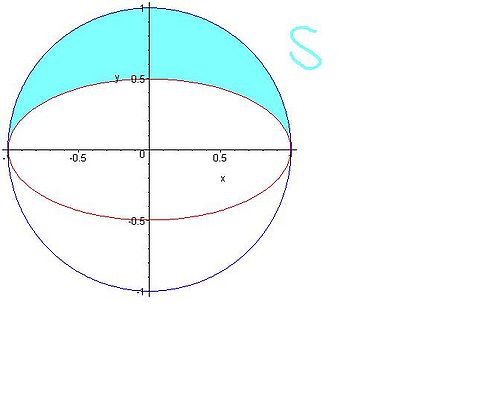A picture when k is 2 is drawn below.

To compute the area of S, we actually don't need to do any more work. Notice that the area of the blue circle when y is greater than 0 is half the area of the unit circle which is  . Now, the area of the ellipse when y is greater than 0 is again half the area of the ellipse, which by the previous problem is
. Now, the area of the ellipse when y is greater than 0 is again half the area of the ellipse, which by the previous problem is  . Hence, the area of S is
. Hence, the area of S is

Now, notice that when x is 0, then the two points on the ellipse are  . So the one lying in the upper half of the plane is
. So the one lying in the upper half of the plane is  . The question asks when is the centroid outside of E (so inside S). By symmetry, the x coordinate of the centroid is 0. So all we need to do is figure out when
. The question asks when is the centroid outside of E (so inside S). By symmetry, the x coordinate of the centroid is 0. So all we need to do is figure out when  (NOTE: There is a bit of ambiguity in the sense that is something on the boundary of S and E inside S or outside of E - I suspect students using greater than or equal to vs just greater than would earn full marks but it is something we should be a bit careful with). In any case, we compute when
(NOTE: There is a bit of ambiguity in the sense that is something on the boundary of S and E inside S or outside of E - I suspect students using greater than or equal to vs just greater than would earn full marks but it is something we should be a bit careful with). In any case, we compute when

Here, the upper curve is the positive half of the circle so

and the lower curve is the upper half of the ellipse so

The picture also clearly shows that we are integrating from  (we could have explicitly found these points of intersection as well). Thus, we have
(we could have explicitly found these points of intersection as well). Thus, we have

where in the last step we factored out a  . Pulling out the terms depending only on k in the integral and using the fact that the integral is the integral of an even function over a symmetric interval yields
. Pulling out the terms depending only on k in the integral and using the fact that the integral is the integral of an even function over a symmetric interval yields

Using the inequality derived above, we have

and this completes the proof.














